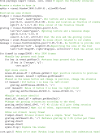Generating Stimuli for Neuroscience Using PsychoPy
- PMID: 19198666
- PMCID: PMC2636899
- DOI: 10.3389/neuro.11.010.2008
Generating Stimuli for Neuroscience Using PsychoPy
Abstract
PsychoPy is a software library written in Python, using OpenGL to generate very precise visual stimuli on standard personal computers. It is designed to allow the construction of as wide a variety of neuroscience experiments as possible, with the least effort. By writing scripts in standard Python syntax users can generate an enormous variety of visual and auditory stimuli and can interact with a wide range of external hardware (enabling its use in fMRI, EEG, MEG etc.). The structure of scripts is simple and intuitive. As a result, new experiments can be written very quickly, and trying to understand a previously written script is easy, even with minimal code comments. PsychoPy can also generate movies and image sequences to be used in demos or simulated neuroscience experiments. This paper describes the range of tools and stimuli that it provides and the environment in which experiments are conducted.
Keywords: EEG; MEG; Python; fMRI; neuroscience; psychophysics; software; vision.
Figures





References
Grants and funding
LinkOut - more resources
Full Text Sources
Other Literature Sources
Research Materials

